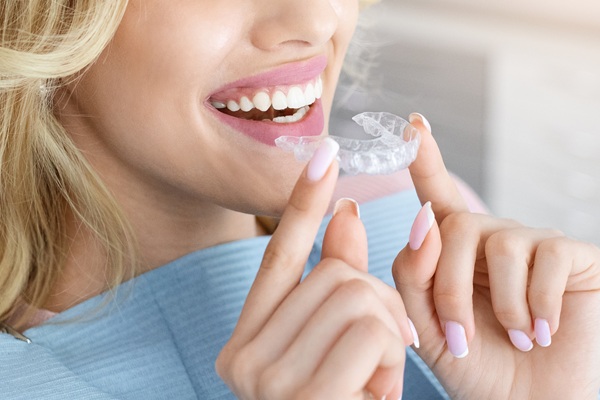The Effects of Smoking During Invisalign Treatment

Invisalign® is a fast way to straighten teeth, using clear, removable trays. However, smoking can negatively impact patient comfort and aligner appearance throughout treatment. It can even prolong treatment times. Learning more about how smoking can affect Invisalign treatment can help motivate patients to limit or quit tobacco altogether.
The effects of smoking during Invisalign treatment
Smoking tobacco can reduce the efficacy and comfort of Invisalign. It also negatively affects oral health, especially when the teeth are shifting around to achieve proper alignment. That is why a general, family, or cosmetic dentist typically recommends stopping or at least limiting smoking and vaping during orthodontic care. Explore the effect of smoking during Invisalign treatment below.
Smoking can damage aligners
Smoke can turn teeth yellow. Similarly, the tar and other residue from tobacco smoke can turn clear trays yellow or brown, making them far more noticeable. Stains often collect in tiny scratches and along the edges, so even new trays can look older than they are.
Heat also matters if the patient smokes while wearing Invisalign aligners. Warm smoke can soften the plastic for short periods, which may change how the trays fit. Even small changes can lead to sore spots, extra rubbing on the gums, or a tray that does not grip as well over the teeth and attachments.
In addition, flavorings and sweeteners in some tobacco and vape products can create a sticky film on aligners. That film attracts plaque and food particles, which dull the plastic and cause an unpleasant smell. It is possible to clean the trays. However, repeated exposure often outpaces basic care, which means the trays will likely need to be replaced often. This results in a slower and more costly treatment overall.
Oral health risks from tobacco use
Smoking and vaping dry out the mouth. Less saliva means fewer natural defenses against acids and bacteria. When Invisalign aligners cover the teeth for most of the day, those acids and bacteria can sit on the enamel and along the gums for longer, which increases the risk of white spots, cavities, and tender gums.
Nicotine is also known to tighten blood vessels in the gums, which can slow the natural process that teeth rely on to move. When gum tissues take longer to adapt to the teeth’s new positions, each treatment stage may need more time. Irritated or bleeding gums around attachments are also more difficult to keep clean, increasing the risk of plaque and tartar buildup in those small, hard-to-reach areas.
Finally, smoking increases the risk of gum disease. According to the Centers for Disease Control and Prevention (CDC), this is because tobacco stunts the immune system and makes it more difficult to fight off gum infections. Because aligners create a low-airflow space, these germs can grow faster. Regular checkups with a general, family, or cosmetic dentist can catch early signs of trouble. Still, limiting tobacco use remains the most powerful way to protect gum health and Invisalign treatment progress.
Get more information
Smoking or vaping does not have to stop you from getting the smile of your dreams. A general, family, or cosmetic dentist can provide more personalized guidance on what to expect during and after Invisalign treatment. If needed, they can also connect you with a medical provider who can assist with smoking cessation. For more information on how to get the most out of Invisalign treatment, reach out to our New York team today.
Request an appointment here: https://www.mydentalspa.net or call M.Y. Dental Spa at (212) 786-5757 for an appointment in our New York office.
Check out what others are saying about our dental services on Yelp: Invisalign in New York, NY.
Related Posts
Dental fillings are one of the most common treatments provided by general dentists. They can restore teeth affected by decay, returning the smile’s full function and appearance. For those new to the process, understanding what to expect can help make the experience smoother and less daunting.Dental fillings repair teeth damaged by cavities or minor fractures.…
A dental filling may be necessary if you are experiencing some discomfort. A visit to the dentist can determine which teeth need this treatment. Awareness that you need a filling can help preserve your teeth longer. Here are the three significant signs you need a dental filling.Pain is a telling sign that the tooth is…
Dental fillings are used to restore teeth that have decay or damage. This procedure restores a tooth's strength, function, and appearance. Fillings close off the cavity, preventing bacteria from getting into the tooth and causing more damage. During the treatment, the dentist will remove the decayed area of the tooth, clean it, and apply the…
Your general dentist may suggest a dental filling after a dental check. Placing a filling on a damaged section of a tooth is a common procedure. You may experience some symptoms after getting your filling. The following are things to anticipate after your dental filling appointment.Studies reveal that the teeth beside the treated tooth may…






